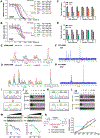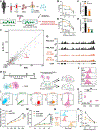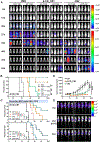Targeting FTO Suppresses Cancer Stem Cell Maintenance and Immune Evasion
- PMID: 32531268
- PMCID: PMC7363590
- DOI: 10.1016/j.ccell.2020.04.017
Targeting FTO Suppresses Cancer Stem Cell Maintenance and Immune Evasion
Abstract
Fat mass and obesity-associated protein (FTO), an RNA N6-methyladenosine (m6A) demethylase, plays oncogenic roles in various cancers, presenting an opportunity for the development of effective targeted therapeutics. Here, we report two potent small-molecule FTO inhibitors that exhibit strong anti-tumor effects in multiple types of cancers. We show that genetic depletion and pharmacological inhibition of FTO dramatically attenuate leukemia stem/initiating cell self-renewal and reprogram immune response by suppressing expression of immune checkpoint genes, especially LILRB4. FTO inhibition sensitizes leukemia cells to T cell cytotoxicity and overcomes hypomethylating agent-induced immune evasion. Our study demonstrates that FTO plays critical roles in cancer stem cell self-renewal and immune evasion and highlights the broad potential of targeting FTO for cancer therapy.
Keywords: FTO; LILRB4; LSC/LIC self-renewal; N(6)-methyladenosine (m(6)A) modification; immune checkpoint genes; immune evasion; inhibitors; leukemia; solid tumors; therapeutics.
Copyright © 2020 Elsevier Inc. All rights reserved.
Conflict of interest statement
Declaration of Interests A provisional patent was filed, with J.C., R. Su, D.H., X.D., H.L., and J.X. as inventors. J.C. is the scientific founder of Genovel Biotech Corp. and holds equities with the company. A.T.F. has done consultancy work for Celgene, Agios, Astellas, Daiichi Sankyo, and Abbvie, and Celgene and Agios are providing funding for two ongoing clinical trials that A.T.F. is running as investigator-initiated studies.
Figures








Comment in
-
It's Not What You Say But How You Say It: Targeting RNA Methylation in AML.Mol Cell. 2020 Jun 18;78(6):996-998. doi: 10.1016/j.molcel.2020.05.027. Mol Cell. 2020. PMID: 32559428
-
RNA methyltransferase inhibitor reduces AML.Nat Rev Drug Discov. 2020 Aug;19(8):510. doi: 10.1038/d41573-020-00120-1. Nat Rev Drug Discov. 2020. PMID: 32601311 No abstract available.
References
-
- Alfayez M, and Borthakur G (2018). Checkpoint inhibitors and acute myelogenous leukemia: promises and challenges. Expert review of hematology 11, 373–389. - PubMed
-
- Baell JB, and Holloway GA (2010). New substructure filters for removal of pan assay interference compounds (PAINS) from screening libraries and for their exclusion in bioassays. J Med Chem 53, 2719–2740. - PubMed
-
- Berger R, Rotem-Yehudar R, Slama G, Landes S, Kneller A, Leiba M, Koren-Michowitz M, Shimoni A, and Nagler A (2008). Phase I safety and pharmacokinetic study of CT-011, a humanized antibody interacting with PD-1, in patients with advanced hematologic malignancies. Clin Cancer Res 14, 3044–3051. - PubMed
Publication types
MeSH terms
Substances
Grants and funding
- R01 CA236399/CA/NCI NIH HHS/United States
- R50 CA211404/CA/NCI NIH HHS/United States
- R01 DK124116/DK/NIDDK NIH HHS/United States
- R01 CA214965/CA/NCI NIH HHS/United States
- R01 CA172558/CA/NCI NIH HHS/United States
- R01 CA169458/CA/NCI NIH HHS/United States
- R35 CA197628/CA/NCI NIH HHS/United States
- P30 CA033572/CA/NCI NIH HHS/United States
- R01 CA243386/CA/NCI NIH HHS/United States
- HHMI/Howard Hughes Medical Institute/United States
- T32 CA186895/CA/NCI NIH HHS/United States
- R01 CA213138/CA/NCI NIH HHS/United States
- R01 CA157644/CA/NCI NIH HHS/United States
- R01 CA211614/CA/NCI NIH HHS/United States
- U10 CA180827/CA/NCI NIH HHS/United States
- R01 CA137060/CA/NCI NIH HHS/United States
LinkOut - more resources
Full Text Sources
Other Literature Sources
Molecular Biology Databases
Research Materials

